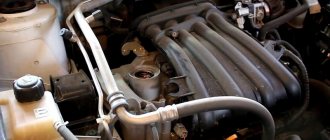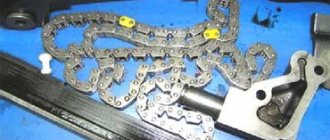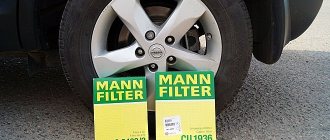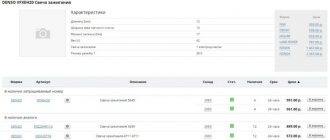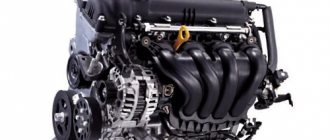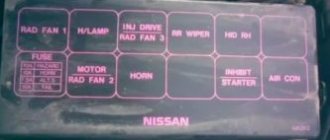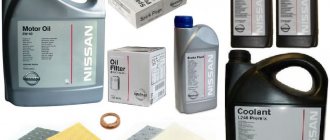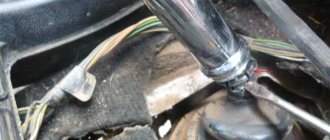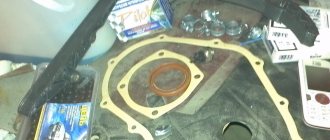Good day!
Today's photo report will show the replacement of a stretched chain in an MR20DD engine, as well as the characteristic symptoms of a stretched chain on a Nissan Qashqai J11.
In our market, this engine has been installed on the Nissan Qashqai J11 since 2013, and on the Nissan X-Trail T32 since 2014.
It is an in-line four-cylinder engine of the MR series with a volume of 1997 cc. cm with direct fuel injection and two variable valve timing.
A 2014 Qashqai with a mileage of 122,000 km came to us with complaints about difficult starting and rough engine operation after starting.
The memory of the electronic engine control unit contained errors P0014 (ignition timing deviation from the norm) and P0300 (multiple misfires).
According to the owner, difficult starting and uneven engine operation appeared some time ago and gradually progressed.
We remove the timing cover: the main chain tensioner is extended by 16mm.
We compare the new and old chains - the stretching is significant. In the photo below, the new chain is hung on top of the old one, you can see the stretch.
This motor was equipped with 2 revision chains, both double-row.
The tensioner itself and dampers are in good condition, so we change the chain ring (of course we install the latest revision), the front crankshaft oil seal and all the sealing rings on the engine cover.
After installing the new chain, the engine started at half a turn.
In addition, engines with direct injection are very sensitive to fuel, so it is recommended to periodically flush the injector for preventive purposes.
If you encounter similar malfunctions in engine operation or hear noises characteristic of chain stretching, do not delay replacement - this will avoid wear on other engine parts.
We wish everyone long and trouble-free operation of your cars!
FUNCTIONAL PURPOSE OF THE TIMING BELT
Replacing the timing belt is part of routine maintenance on your Nissan Qashqai and plays an important role in the performance of the vehicle's engine. Untimely replacement of the belt can lead to a malfunction of the engine, and a break can lead to deformation of the gas distribution valve and the need for a major engine overhaul.
All parts of the gas distribution mechanism are closely connected to each other; the injection of the air-fuel mixture drives the piston of the engine cylinder, which in turn pushes the crankshaft, connected by a drive belt to the camshaft. Thus, the camshaft moves, which regulates the frequency of valve movement. The Nissan Qashqai timing belt connects the gears together and transmits torque from the crankshaft to the camshaft, affecting its rotation speed. If the system is working properly, their speed should be equal.
TYPES OF TIMING BELT FAULTS
- Wear of the timing belt leads to a change in the torque transmission force from the crankshaft to the camshaft, resulting in a change in the frequency of movement of the engine pistons and valves. This, in turn, leads to a malfunction of the gas distribution system, rapid heating of the engine and, as a consequence, a decrease in engine power and an increase in consumption of the fuel mixture. For reliable and uninterrupted operation of the engine, it is necessary that the valves close and open at the same frequency as the engine pistons. If the timing belt slips due to wear, it can cause a break.
- A broken Nissan Qashqai timing belt is the most dangerous damage to the engine. If such a malfunction occurs, the camshaft ceases to be connected to the crankshaft and can stop completely arbitrarily in a position in which any of the valves of the gas distribution mechanism is open. In this case, the piston, moving upward, may collide with the valve, which will lead to its deformation. In this case, the car engine faces serious repairs. It should be noted that a timing belt break does not occur unexpectedly; it is almost always accompanied by changes in the operation of the car engine, a decrease in its power, a change in gasoline consumption, the appearance of extraneous squeaks, creaks, etc.
To prevent and prevent the operation of the gas distribution mechanism, it is necessary to periodically replace the timing belt; this will save the Nissan Qashqai engine from breakdown, prevent premature engine wear and increase its service life.
CAUSES AND ASSESSMENT OF TIMING BELT WEAR
Timing belt wear occurs for a number of reasons, avoiding which can extend the life of the car engine.
To prevent complete wear of the timing belt, it is necessary to periodically, during a visual inspection of the gas distribution mechanism, check for damage to the surface of the belt. To inspect and evaluate the belt drive, it is necessary to unscrew and remove the protective casing of the mechanism under which the engine is hidden. The first signs of wear are:
- the appearance of oil and antifreeze smudges capable of chemically destroying the timing belt, with prolonged exposure;
- the occurrence of longitudinal cracks on the rear surface of the belt;
- formation of transverse cracks on the inner surface of the drive belt;
- a torn surface and a broken edge are also signs of wear;
- Rubber dust on the surface of the part also indicates belt wear;
- If the timing belt teeth begin to peel off or wear off, the part must be immediately replaced with a new one.
SIGNS OF A FAULTY TIMING BELT
- Gasoline consumption by car has increased
- Engine power has decreased
- A complete stop of the car while moving; when you try to start, the engine does not start, and the starter rotates more easily than usual
- Unstable engine operation at idle and while driving;
- The occurrence of shots in the injector receiver and exhaust pipe
All these problems may indicate a shift in the valve timing and loosening of the belt tension. If you notice one or more signs from this list on your Nissan Qashqai, immediately contact a service station for an inspection.
HOW OFTEN IS IT NEEDED TO REPLACE THE TIMING BELT FOR A Nissan Qashqai
The frequency of replacing any consumables for cars depends on the driving style and operating mode of the car. In case of extreme driving style and aggressive use of the vehicle, it is necessary to replace the timing belt as it wears out and the teeth wear out.
Under normal operating conditions, it is necessary to replace the original timing belt as planned, every 60 - 70,000 km. mileage During this period, it exhausts its resource and becomes unusable. If your Nissan Qashqai is equipped with an analog belt, replacement must be made a little earlier than the time recommended by the vehicle manufacturer.
WHICH TIMING BELT IS BETTER TO CHOOSE
Modern belts for the gas distribution system are a high-tech product, characterized by increased strength and wear resistance, capable of withstanding high dynamic loads. Timing belts are made from neoprene or polychloroprene with reinforcement with strong cord threads made of fiberglass, nylon and cotton.
- To avoid the mistake associated with purchasing a timing belt, contact specialists who will help you, using your car’s WIN code, order a timing belt suitable for your car’s engine. This part is one of the most important in the engine design; the slightest deviation in the length, width, shape and size of the teeth can lead to problems with the Nissan Qashqai engine.
- Do not try to save money when buying a timing belt; a cheap product may be a low-quality fake that will quickly become unusable and in the future may cause serious engine damage. The best option for any car is original parts; their cost is higher than analogue ones, but when using the car they quickly pay for themselves.
- When purchasing a timing belt, check its rigidity; a good belt should be elastic and bend easily. The worse the belt, the stiffer it will be.
- The presence of teeth, sagging, or pores on the belt is not allowed - these are signs of a low-quality belt that will quickly become unusable. The surface of the product must be smooth, small burrs are allowed.
- When purchasing it yourself, check the timing belt part number printed on the back side; it must correspond to the WIN code of the car. If it is not possible to compare the code of the belt and the car, then it is necessary to make a visual comparison of the old and new belt; they must be completely identical.
- To avoid buying counterfeits, try to purchase spare parts only from official, trusted dealers.
- Don’t skimp on a qualified timing belt replacement; contact our certified auto service center, where competent mechanics will help you repair your Nissan Qashqai. And in the spare parts store you can buy original spare parts for your car.
Replacement
Timing chains for
Nissan
Qashqai
Chain
The timing belt ensures the rotation of the engine shafts, through which air is mixed with fuel in the required proportion and enters the vehicle’s power unit, and exhaust gases in this case are removed using it.
The operation of the gas distribution mechanism directly affects the performance of the engine, so its condition must be carefully monitored and if the slightest signs of malfunction are detected, it must be addressed. When the timing chain
, or timing belt, breaks, expensive car repairs are inevitable.
Replacing the timing belt on a 1.5 Nissan Qashqai diesel engine
The first generation Japanese car Nissan Qashqai is equipped with four types of power units, and only the 1.5 liter K9K diesel engine manufactured by Renault is equipped with a timing belt drive.
The work of replacing the alternator belt on a Qashqai does not require any special skills or any qualifications; almost any driver can do it with his own hands. But before we talk about replacing drive belts, let’s first consider what types of motors were installed on the Nissan Qashqai J10 model.
Chain: pros and cons
The main argument for fans of chain drive is its durability. In fact, if the belt is designed for 40-60 thousand car mileage, then the chain can go 300 without problems (you just need to monitor it and tighten it periodically). This is probably why the Japanese, who traditionally value longevity and strength, install mainly a chain on the Nissan Qashqai.
Types of engines installed on the Nissan Qashqai crossover
The lineup of Qashqai J10 power units is represented by 4-cylinder engines:
- petrol HR16DE 1.6 l (16 valves, 108-118 hp);
- petrol MR20DE 2.0 l (16 valves, 133-141 hp);
- diesel K9K 410 1.5 l (8 valves, 103 hp);
- diesel M9R 2.0 l (16 valves, 90-114 hp).
The HR16DE, MR20DE and M9R engines have a reliable timing chain drive, the K9K engine is equipped with a timing belt drive.
Nissan Qashqai: alternator belt replacement 2.0
To replace the accessory belt on a Nissan Qashqai with the MR20DE engine, you need to remove the front right wheel; in order to loosen the belt, you need to get to the tension roller. We carry out the work in the following order:
- dismantle the wheel;
- we unclip the clips securing the plastic protection from below, now you can get to the tension roller;
- Using a 14 mm wrench, turn the bolt located in the center of the roller (clockwise);
- to fix the roller in the depressed state, place the lock in the hole located in the timing cover;
- remove the loose belt and install a new one;
- remove the latch, tighten the strap, put the guard and wheel in place.
Belt: pros and cons
- The belt is elastic and quiet, absorbs vibrations well from torsion, and does not require lubrication;
- Its faults can be easily diagnosed and eliminated without fundamental disassembly of the engine blocks. It can be changed according to the staffing schedule, when critical resource expenditure is still relatively far away.
The main disadvantage is vulnerability and dependence on external natural conditions, as well as technical ones: ingress of lubricant, for example.
If the belt breaks, the camshaft is no longer in sync with the crankshaft and the pistons hit the valves when they are open. Result: repair of engine compartment valves and many more troubles, including capital.
Replacing the timing belt of a Nissan Qashqai on a K9K 410 diesel engine
To replace the timing belt on a 1.5 liter DCI internal combustion engine, the car should be placed on a level surface, but it is more convenient to carry out the work on a car lift.
We make the replacement in the following order:
- in the same way as when replacing the drive belt, first of all we remove the front right wheel and leave the car on a jack;
- remove the plastic casing under the engine on the right side;
- we stop the internal combustion engine from turning, loosen the crankshaft pulley bolt;
- press the tension roller with a key to 14, remove the generator belt;
- We place a support, for example, a wooden log, under the engine oil sump;
- dismantle the right front engine support;
- unscrew the fasteners and remove the two timing belt covers (upper and lower);
- completely unscrew the bolt of the pulley to the shaft, dismantle the pulley;
- We set the marks of the gas distribution mechanism. To do this, rotate the crankshaft so that the hole in the r/shaft gear coincides with the hole in the cylinder head; when aligned, insert a stopper here (a pin, or a drill);
Regulations for replacing the timing belt on the K9K engine (diesel)
The rules for replacing the timing belt are set differently - European reference books indicate that the parts of the gas distribution mechanism (belt and roller) must be changed after 160 thousand km, Russian servicemen claim that replacement is required every 60 thousand km. This is due to the fact that the factory belt installed on a European car is of very high quality, which cannot be said about the parts supplied to the Russian market. The life of the timing belt is also affected by driving style, and it should be noted that Europeans drive much more carefully - without sudden starts and braking.
It is impossible to tighten the replacement of timing parts on a 1.5 DCI diesel engine; if the belt breaks, the valves will be bent due to the impact on the pistons, and in this case the repair will be serious, and most importantly, it will be expensive.
Nissan Qashqai: Timing chain or belt? Pros and cons of the belt
Average price - rub. Also, when replacing the timing chain, the following parts are changed along the way: The timing chain is located on the side of the engine, under a special protective cover. Manufacturer: CGA. The average price of a spare part is RUB. The main advantage of this model is its lower price than the original; ET Typically this part requires replacement every km.
If you hear knocking and metallic rumble while driving, it means the chain has stretched and is slipping. If such symptoms occur, replacement is required immediately! There may also be a decrease in engine power, a thick bluish-colored exhaust, loud sounds in the muffler, a sudden increase in engine temperature for no apparent reason - it is by these signs, which most often appear not individually, but together, that the wear of an element can be easily determined. Have you bought any used car?
Be sure to inspect the chain, even if the owner says he recently changed it. In some cars, if there are problems with the gas distribution mechanism, a special indicator lights up on the dashboard. If the chain is not replaced in a timely manner, it will jump and damage the cylinder head.
Nissan Qashqai Club
Further events depend on many factors. In the best case, the valves simply bend.
In the worst case scenario, their constituent elements rupture and the cylinder block becomes unusable. On the left is an old, stretched chain. Each option has its advantages and disadvantages. When installing a single-row version, the engine power increases slightly and the noise level decreases.
The fact is that it is easier for the power unit to rotate one row of chain than two.
As for the belt, the life reserve of which these natural phenomena can significantly reduce; Another important quality: Nissan Qashqai has a timing belt or chain, this means the accuracy of the timing phase - with revs, the shaft alignment will be maintained, which ensures higher power characteristics of the engine; If the tensioner is working properly, the chain does not jump from tooth to tooth, without disrupting the distribution phases; The belt is afraid of oil, the chain is not; But the hydraulic chain tensioner functions rather poorly at low oil pressure, which still allows for the possibility of jumping a tooth during startup or abnormal pressure surges.
It can be changed according to the staffing schedule, when critical resource expenditures are still relatively low. The main disadvantage is vulnerability and dependence on external natural conditions, as well as technical ones: Plus, it does not need to be lubricated.
Belt drive faults are very easy to identify. To do this, you do not have to disassemble the power unit even partially.
The replacement of the unit can be completed even before the deadline. A huge disadvantage can and should be considered a strong dependence on external factors. We are talking about weather conditions, for example, as well as technical issues, such as oil ingress.
Timing belt replacement frequency for Nissan Qashqai
Nissan Qashqai I 2007 - 2014
- What timing drive is on the Nissan Qashqai? – 2 answers
- When should you change the timing belt in a Nissan Qashqai? – 1 answer
- Timing chain or belt on the HR16DE engine, Nissan Qashqai - 1 answer
If the engine is a diesel engine, then the timing belt is changed for the first time after 120,000 km, subsequent times after 60,000 km, the replacement is described in detail here.
If the engine is gasoline, then the timing chain changes when stretched (it lasts approximately 150,000-200,000 km).
Subscribe
to our channel in
Index.Zen
Even more useful tips in a convenient format
When should you change the timing belt in a Nissan Qashqai?
What timing drive is on the Nissan Qashqai?
Timing chain or belt on HR16DE engine, Nissan Qashqai
see also
What kind of timing chain is on Qashqai and its price?
- 0 1 2k
When to change the timing chain on a Nissan Qashqai?
- 0 1 12k
Timing chain Nissan Qashqai
- 41 0 22k
What timing drive is Nissan Qashqai?
- 0 1 2k
What timing drive is in the Nissan Qashqai 2?
- 0 1 1k
Nissan Qashqai is equipped with petrol engines HR16DE (1.6), MR20DE (2.0) and diesel units M9R (2.0), K9K (1.5). On gasoline engines, regardless of the type of engine, the movement of the camshaft is driven by a chain drive. On diesel engines, the timing chain is only installed on the M9R (2.0).
According to the Qashqai technical data sheet, the procedure for replacing the timing chain is provided for TO 6. See the photo report for how to cope with replacing the chain yourself.
Replacing the timing chain on a Nissan Qashqai
The timing chain ensures the rotation of the engine shafts, due to which air is mixed with fuel in the required proportion and enters the vehicle’s power unit, while exhaust gases are removed from it. The operation of the gas distribution mechanism directly affects the performance of the engine, so its condition must be carefully monitored and measures taken if the slightest signs of malfunction are detected. When a timing chain or belt breaks, expensive vehicle repairs are inevitable.
CHECKING AFTER INSTALLATION
CHECKING AFTER INSTALLATION
Leak check
Before starting the engine, check the oil/fluid levels, including engine coolant and engine oil. If the level is below normal, add and bring to the required level. See chapter MAINTENANCE.
Check for fuel leaks as follows:
Turn the ignition key to the “ON” position (without starting the engine). After creating pressure in the fuel lines, check for fuel leaks at the joints.
Start the engine. While increasing the engine speed, check again for fuel leaks at the joints of the fuel lines.
Run the engine and check for unusual noise or vibration.
Note: If the hydraulic pressure inside the timing chain tensioner drops after removal/installation, slack in the guide may cause a clunking noise when the engine is started and immediately thereafter. However, this does not indicate a malfunction. The knocking will stop after the hydraulic pressure rises.
Warm up the engine thoroughly and make sure there are no fuel or oil/fluid leaks, including engine coolant and engine oil.
Bleed the air from the pipes and hoses of the relevant systems, such as the cooling system.
After the engine has cooled, check the oil/fluid levels again, including engine coolant and engine oil. If necessary, top up and bring to the required level.
Check table
| Component | Before starting the engine |
FUNCTIONAL PURPOSE OF THE TIMING CHAIN
The Nissan Qashqai timing chain drive is part of the gas distribution mechanism and is involved in the transmission of torque from the crankshaft to the camshaft. The chain can connect them directly or participate in the work indirectly, for example, combining camshafts with each other, if there are two of them, while its functional purpose remains unchanged.
Monitoring the condition of the timing chain, replacing dampers and tensioners is part of routine vehicle maintenance and plays an important role in the operation of the vehicle engine. It is necessary to regularly monitor the condition of the gas distribution system, as this directly affects the vehicle’s power, sensitivity when supplying gas and fuel consumption.
FEATURES OF CHAIN REPLACEMENT
In most engines of older car models, chains with roller links were used to transmit torque, often the components were in two or three rows, this made the timing chain a very reliable, almost eternal mechanism that does not require constant maintenance. Often the car traveled up to 300,000 km. and the chain of the mechanism received only lateral play, and the worst thing that could happen to the gas distribution mechanism was the links jumping; breaks were extremely rare. Over time, production price, efficiency, environmental friendliness and the weight of the car engine, which affects its power, have become trends in the creation of cars. Under these conditions, manufacturers began to strive to replace the timing chain with a lighter, cheaper and easier to maintain timing belt. And those motors whose design retained chains and roller components were replaced with lightweight plate links, more reliable than timing belts, but still not as strong as roller chains.
The Nissan Qashqai timing chain has a number of features that fundamentally distinguish it from the timing belt.
1. The chain is a durable mechanism; it wears out much longer than the timing belt; breaks do occur, but much less frequently than in belt-driven engines.
2. A break in the timing chain occurs quite rarely, which means engine breakdowns requiring expensive overhauls do not occur often.
3. Timing chains are quite noisy, but with the modern level of car noise insulation, this parameter becomes not very important.
4. When the chain wears out, its play and lateral runout occur, this indicates the need to replace the old chain with a new one. Since the metal part sagging and lateral runout is accompanied by strong noise, it is simply impossible not to notice and not to attach significance to it. A noise under the hood will be the first “bell” indicating the need for vehicle maintenance.
5. The main disadvantage of replacing the Nissan Qashqai timing chain is that it is located inside the cylinder block and it is quite difficult to assess its condition without training and experience. In addition, dismantling and replacement, with such a device, is a long and labor-intensive process, and therefore expensive.
6. The operation of the timing chain involves tensioners and dampers - these are consumable parts that wear out quickly and require more frequent replacements than the timing chain itself.
TYPES OF FAULTS
1. Timing chains, when in full working order, have a natural movement, which is compensated by tensioners when oil pressure is applied. A malfunction is considered to be a strong lateral runout of the timing chain, which appears when the links are stretched. The actual degree of chain stretch can only be determined through a qualified inspection of the gas distribution mechanism.
2. Backlash is a direct stretching of the chain, which is observed during long-term operation, can lead to jumping of chain links and malfunction of the gas distribution mechanism, this leads to a decrease in the sensitivity of the engine when the gas pedal is pressed and an increase in fuel consumption.
3. Timing chain break in Nissan Qashqai is the most dangerous damage to the engine; in the case of a chain drive motor, it does not occur often, but it does occur. If such a malfunction occurs, the camshaft ceases to be connected to the crankshaft and can stop completely arbitrarily in a position in which any of the valves of the gas distribution mechanism is open. In this case, the piston, moving upward, may collide with the valve, which will lead to its deformation and the car engine will face serious repairs. It should be noted that a timing chain break does not occur unexpectedly; it is almost always accompanied by changes in the operation of the vehicle, a decrease in its power, a change in gasoline consumption and the appearance of extraneous noise.
To prevent and prevent the operation of the gas distribution mechanism, it is necessary to periodically troubleshoot the timing chain; this will save the car engine from breakdown, prevent premature engine wear and increase its service life.
CAUSES OF WEAR
1. Operation of the Nissan Qashqai in extreme conditions. Frequent driving on unpaved roads, towing trailers, heavy loads, and traveling at high speeds increases the load on the crankshaft, spinning it to maximum speed, which leads to stretching of the timing chain.
2. Since the timing chain is located inside the cylinder block, it is completely washed by engine oil and, as a result, is very sensitive to its quality. In the case of using high-quality synthetic oil containing specialized detergent additives, the service life of the timing chain is significantly increased.
3. The operation of the timing chain involves parts that regulate the tension of the chain; they are consumables and require periodic replacement. During vehicle maintenance, it is necessary to check the degree of wear of the tensioner and the “calculator”; untimely replacement of these parts can lead to stretching of the chain and skipping of links.
SIGNS OF PROBLEM
1. Increase in gasoline consumption by car;
2. Reduced engine power; 3. The appearance of clanging and noise under the hood of the car when the engine is running;
4. A complete stop of the car while moving; when you try to start, the engine does not start, and the starter rotates more easily than usual;
5. Unstable operation of the Nissan Qashqai engine at idle and while driving;
6. The occurrence of shots in the injector receiver and exhaust pipe.
All these problems may indicate a shift in the valve timing and loosening of the chain tension. If you notice one or more signs of this list on your car, immediately contact a service station for an inspection.
HOW OFTEN DO YOU NEED TO REPLACE THE TIMING CHAIN?
The frequency of replacing any consumables for Nissan Qashqai cars depends on the driving style and operating mode of the car. With an extreme driving style and aggressive use of the vehicle, it is necessary to replace the timing chain as it becomes loose and wears out.
Under normal operating conditions, it is necessary to replace the timing chain as planned, every 100 - 150,000 km. mileage If your car has an analog belt, replacement must be done a little earlier than the time recommended by the vehicle manufacturer.
Trust your car only to professional specialists who are capable of competently troubleshooting the timing chain, assessing lateral runout and play, replacing and adjusting the operation of tensioners, chain drive “pretensioners” and replacing the Nissan Qashqai timing chain.
The timing chain ensures the rotation of the engine shafts, due to which air is mixed with fuel in the required proportion and enters the vehicle’s power unit, while exhaust gases are removed from it. The operation of the gas distribution mechanism directly affects the performance of the engine, so its condition must be carefully monitored and measures taken if the slightest signs of malfunction are detected. When a timing chain or belt breaks, expensive vehicle repairs are inevitable.
Features of the chain mechanism on the Nissan Qashqai
The timing belt on Nissan Qashqai with engine volumes of 1.5 and 2.0 liters, as well as on other chain-type gasoline units, while the gas distribution system of the Nissan Qashqai 1.6 liter, which uses diesel as fuel, has a timing belt.
Replacing the mechanism chain of Nissan Qashqai 2.0 l, 1.2 l, 1.5 l should be carried out according to the regulations every 150–200 thousand km, and the belt on 1.6 l diesel engines should be changed after the same time period.
The chain mechanism is more reliable and durable compared to a belt, and, as a rule, it has to be changed less often than is usually indicated in the manual. In most cases, it effectively performs its functions even after 150 thousand km and can last up to 250–300 thousand km without complaints.
However, unlike a belt, the chain system contributes to a higher noise level when the motor is running, and also has more complex work when changing this element.
Engine design Qashqai 1.6
The Qashqai HR16 engine is 1.6 liter, it is a petrol 4-cylinder 16 valve unit. The in-line engine has an aluminum cylinder block with so-called “wet liners”. The cylinder head does not have hydraulic compensators. The thermal clearance of the valves is adjusted by selecting pushers of different thicknesses. Two camshafts are located in the cylinder head bearing housing. The timing drive uses a chain. For better fuel efficiency, two injectors per cylinder are used. Electronically controlled fuel injection. An actuator for the variable valve timing system is installed on the intake shaft.
Nissan Qashqai 1.6 engine cylinder head
The Nissan Qashqai cylinder head is made of aluminum alloy. An actuator for changing valve timing (phase shifter) is installed on the intake camshaft. The phase regulator mounted on the intake camshaft is controlled by increasing the engine oil pressure from the drive system. An increase in pressure causes an increase in the deviation of the camshaft from the nominal position relative to the valve axes. The oil pressure level is regulated by a solenoid valve controlled by the electronics of the Nissan Qashqai engine.
Oil pump Qashqai 1.6
The oil pump is located in the sump. The pump has its own separate chain drive from the crankshaft sprocket, due to which the torque is transmitted to the pump sprocket.
How to replace a mechanism chain
When working with the timing chain on a Nissan Qashqai 2L or other gasoline engines, done with your own hands, you must follow the following sequence of actions:
- Remove the right front wheel.
Then you should remove the fender liner and drain the oil.
Attention! It is important to carry out all work with a cold engine!
The next step is to install a new part of the gas distribution mechanism.
Change - so completely
It may seem that Qashqai has no chronic diseases. However, this, alas, is not the case: there is still a fly in the ointment.
The problem area of the Kashkaya was the suspension. Shock absorbers rarely last longer than 30,000 km, and their mileage does not depend too much on operating conditions. Therefore, since 2009, parts from X-Trail began to be installed on Qashqai. Now shock absorbers last much longer and can last 75,000–100,000 km without replacement. But only the front and rear ones still have to be refreshed every 35,000–50,000. The problem lies in weak bushings , which are not replaced separately, only together with the shock absorber.
When to change the timing belt on a Nissan Qashqai
Nissan Qashqai has two generations: J10 (2006-2013) and J11 (2014 - now). The car is available with two petrol engines - 1.6 liters (HR16DE) and 2.7.0 liters (MR20DE), as well as a 1.5 liter diesel carrier (K9K).
The drive torque design for Nissan Qashqai differs depending on the engine type. In fact, a timing chain is fitted to all Qashqais. The only exception is the car with the 1.5-liter K9K engine. This engine has a belt.
